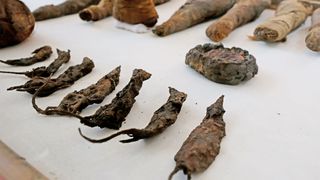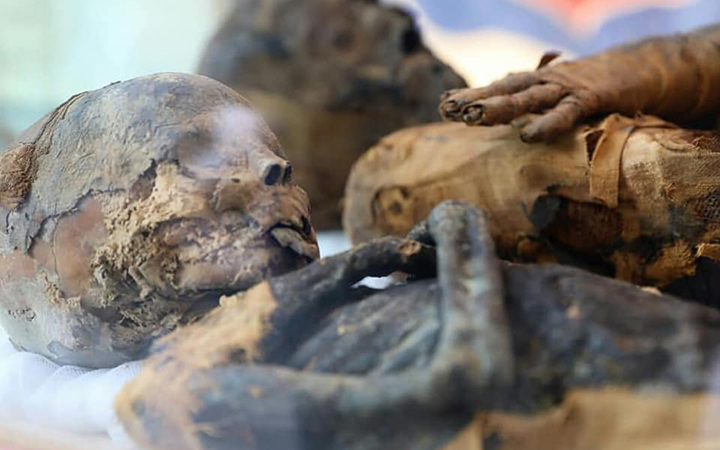Dozens of Mummified Mice and Birds Found in Ancient Egyptian Tomb

A tomb that was recently unearthed in Egypt holds a collection of about 50 mummified animals, including mice, falcons, cats and dogs.
Inscriptions in the tomb indicate that it was built for a man named Tutu and his wife, Ta-Shirit-Iziz, about 2,000 years ago, Egypt's Ministry of Antiquities announced on April 5 in a Facebook post. Authorities had located the tomb and its entrance in October 2018, after they apprehended a team of looters who were attempting to tunnel into a nearby dig site, Reuters reported.
When archaeologists and ministry officials entered the tomb, they found an exquisitely preserved burial chamber, decorated with brightly colored paintings of Egyptian gods and scenes of funerary rituals, ministry representatives said in the statement. [Photos: Canine Catacomb Was Tribute to Ancient Death God]
The tomb is located near the Nile in Akhmim, Egypt — about 280 miles (450 kilometers) to the south of Cairo — and dates to the early Ptolemaic period (305 B.C. to 30 B.C). A passageway extends from the entrance to a main burial chamber, which holds two stone coffins. Painted scenes of Tutu exchanging gifts with Egyptian gods of the dead, such as Anubis and Osiris, adorn the corridor walls; inscriptions record the names of Tutu's parents and Ta-Shirit-Iziz's parents, according to the ministry.
Tutu may have served as a senior government official in the region, Agence France-Presse reported.
Two clay jars that flank the entryway contained the remains of a woman who died between the ages of 35 and 50 and a boy who was about 12 to 14 years old when he died. Dozens of mummified animals were also preserved in the tomb's chambers, according to Reuters.
Egyptian burial sites sometimes contain mummified household pets such as cats. However, the mice, falcons and other animals in the tomb were probably not buried with the occupants as pets, but were more likely votive offerings, Salima Ikram, a professor of Egyptology at the American University in Cairo, told Live Science in an email.
Sign up for the Live Science daily newsletter now
Get the world’s most fascinating discoveries delivered straight to your inbox.
"The animals were probably put in much later and did not have anything to do with the humans," said Ikram, who was not involved in the tomb's excavation.
- Image Gallery: Egypt's Great Terrace of God
- Photos: Mummies Discovered in Tombs in Ancient Egyptian City
- 25 Grisly Archaeological Discoveries
Originally published on Live Science.

Mindy Weisberger is an editor at Scholastic and a former Live Science channel editor and senior writer. She has reported on general science, covering climate change, paleontology, biology and space. Mindy studied film at Columbia University; prior to Live Science she produced, wrote and directed media for the American Museum of Natural History in New York City. Her videos about dinosaurs, astrophysics, biodiversity and evolution appear in museums and science centers worldwide, earning awards such as the CINE Golden Eagle and the Communicator Award of Excellence. Her writing has also appeared in Scientific American, The Washington Post and How It Works Magazine. Her book "Rise of the Zombie Bugs: The Surprising Science of Parasitic Mind Control" will be published in spring 2025 by Johns Hopkins University Press.
